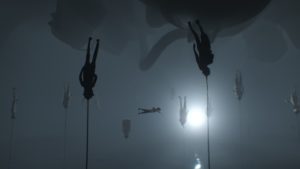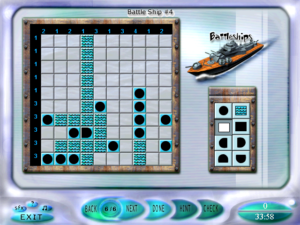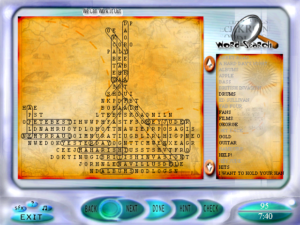Inside
 I’ve been seeing Inside mentioned a lot lately, chiefly in two ways: “This looks a lot like Limbo” and “Oh my god the final level”. The general reluctance to elaborate on the latter sentiment got me curious enough to try it for myself.
I’ve been seeing Inside mentioned a lot lately, chiefly in two ways: “This looks a lot like Limbo” and “Oh my god the final level”. The general reluctance to elaborate on the latter sentiment got me curious enough to try it for myself.
I won’t spoil the final level (even as I show no such restraint for the rest of the game), but I’ll elaborate a little. It’s audacious. It’s unexpected, but it doesn’t come out of nowhere. And it’s gross, but in a way that’s more funny than than anything else, which comes as a relief after the tension and creepiness that dominates the rest of the levels. This change in tone is part of what makes it audacious, and probably part of why it’s provoked such strong reactions.
As for the resemblance to Limbo, the first thing I have to say is that it’s not alone. Limbo seems to have inspired an entire genre of grayscale puzzle-platformers. Inside at least has the excuse of being by the same developers as Limbo, and it uses the formula as a launching-point, not a constraint. For one thing, it’s not really grayscale. It’s just highly desaturated, and it seems like the desaturation is mostly a way to represent dim lighting. Whevener a really bright light hits the player character, you see just how vividly red his shirt really is.
The opening of Inside is surely meant to remind us of Limbo, starting as it does with a boy alone in a dark forest, with not a word of explanation. But as the game went on, I kept encountering scenes that reminded me more of other games: Canabalt, Another World, Heart of Darkness, even Oddworld: Abe’s Oddysee at one point. They key difference is story. Limbo has about as much story as your average dream. It’s all about mood, not narrative, and scenes flow into each other without a lot of logic. Inside quickly makes a promise of greater coherence by grounding itself in the realistic: at the point in Limbo where you start encountering giant spiders, Inside instead gives us a couple of grownups with flashlights standing next to a large truck. On seeing them, the PC shifts unbidden into stealth mode — there’s no manual stealth toggle in this game, just automatic variations in posture and movement that indicate to the player what sort of scene we’re in — and we understand that we’re being hunted. That is effective storytelling.
(Spoilers intensfy from this point on.)
There are no words in this game. The story is told mainly through environment. You tumble down a highway embankment and escape to an abandoned farmyard, where you see dead pigs piled up — some sort of disease? Is that why they’re hunting me, because I’ve broken quarantine? Then a seemingly-dead pig stands up and attacks you: Oh no, is this a zombie apocalypse story? Well, there are zombies of a sort, it turns out, but they’re not Romero-style killer ghouls. Rather, they’re the sort that’s passive unless controlled. One of the game’s more striking images comes when the trucks from the beginning unload a cargo of zombies, presumably collected by those men with flashlights. Unloaded, the zombies form orderly queues and march into a compound of some sort, clearly receiving signals from some unseen source.
The brilliant part of this is that at certain points you can find the machines that control the zombies, consisting of a sort of glowing helmet connected to a device with an antenna, and use them yourself. You may be working against the people doing this, at least to the extent that they’re trying to capture you and you’re trying to not be captured, but that doesn’t prevent you from using their tools to your advantage. There’s even a bit where you daisy-chain it by making a zombie put on a second helmet, effectively acting as a repeater to reach a zombie that’s out of your range. Through this, I kept thinking: This is about the player/character relationship. The boy controls the zombies in a similar way to how I control the boy. In a sense, the daisy-chaining of control was already happening.
Things keep getting more science-fictional as the story ramps up, with the appearance of large possibly-alien machines, but the full story of what’s going on never becomes completely clear. In a guarded complex, we see a roomful of zombies floating upside-down underwater, their heads hooked up to zombie-control helmets. Why? To strengthen a signal, maybe? Is the large spherical device at the heart of it all something that the technicians built, or something that they found and are studying? I do have a sense that, unlike in Limbo, the developers have definite answers in mind, and that I could possibly figure it out if I paid enough attention to details. But simply playing through the game is not enough to fully understand it. Maybe it really is chiefly about mood after all, with just an illusion of story to provoke that mood.
 Comments(1)
Comments(1)




